White walls can be a deliberate choice. More often they are the unimaginative default. Where to begin? Consider the style and era of your house; muse on favorite colors and patterns; look at the proportions of rooms.
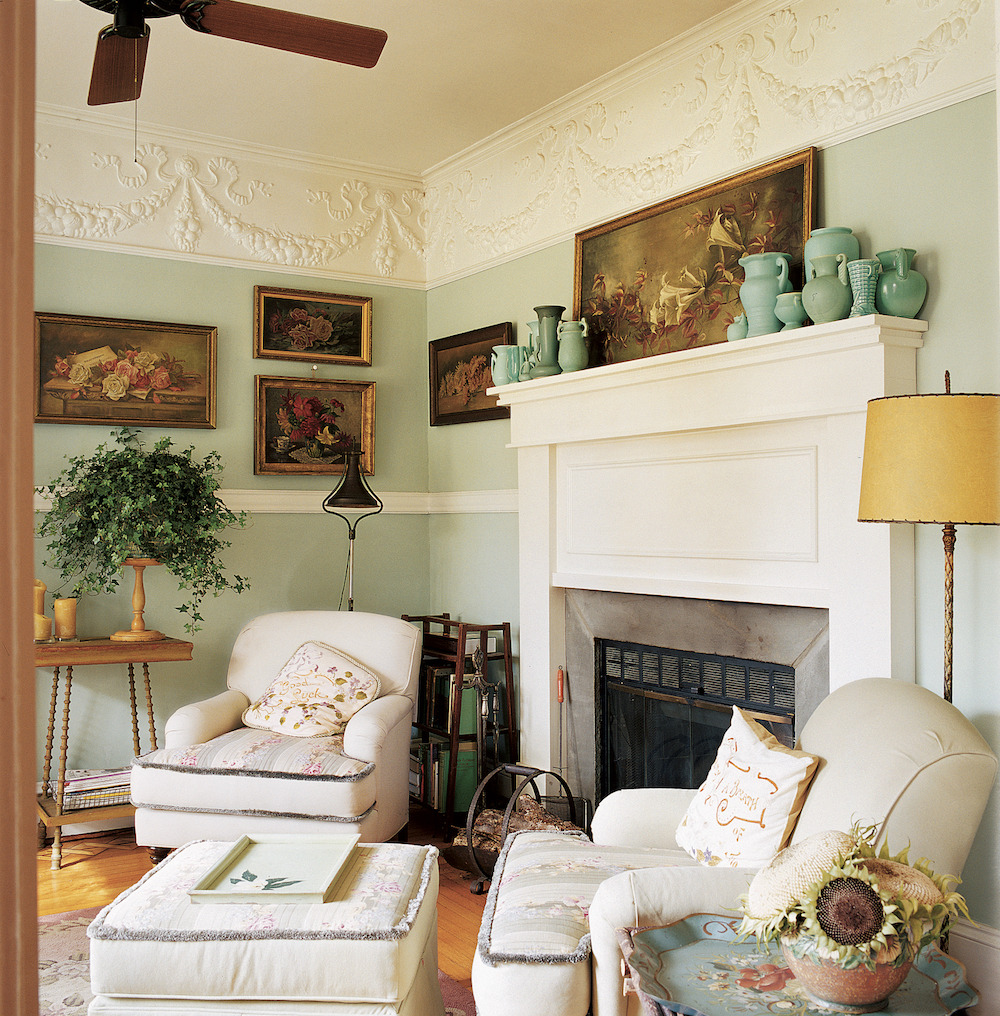
Gross and Daley
Powder rooms are a favorite place to find a creative use of wallpaper today. People aren’t afraid of pattern and color, it seems, when creating a jewel-box in a small space. In other rooms, they’re using paper (peel-and-stick?) or a bold color on just one wall. It’s a start!
My own 1904 house has shellacked beadboard, Arts & Crafts paper friezes in bedrooms, and pigmented plaster in the dining room. Nevertheless, it’s downright conventional compared to many of the homes I’ve toured and the options still available. I can’t help but see white walls as primed for a finish.
Take a stroll through decorating history to find more ideas than you can use in one house—or many. Pattern has come in the form of stenciled decoration, freehand painting and murals, and, especially, in wallpapers. The range of designs is indescribably diverse, taking in traditional favorites with vining or flower or bird motifs as well as stylized and geometric patterns. Some historic-reproduction papers will knock your socks off with their apparent modernism or surprising use of color.
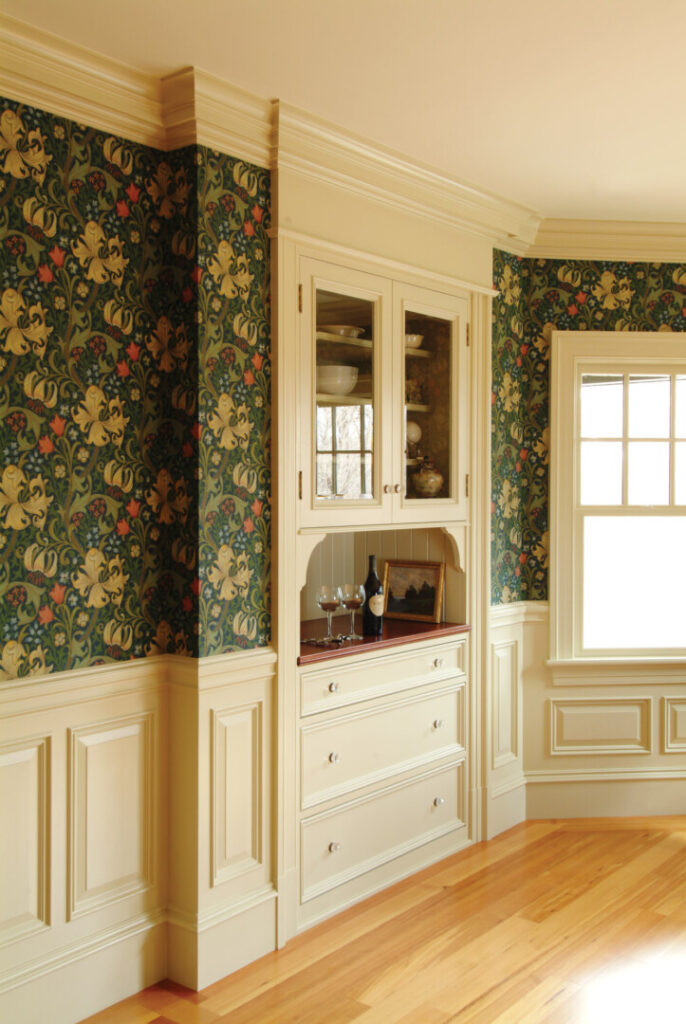
Eric Roth
Even without pattern, wall finish may signify a style. Troweled finish plaster and specialty textures come to mind, symbols of “old world” craftsmanship. Textured walls are used in Spanish Colonial, Mediterranean, and Tudor Revival styles. Sand finishes—with builder’s silica sand incorporated into the paint—show up in Craftsman ceiling coffers as well as the revival houses.
Three-dimensional ornament goes beyond texture. Plaster, composition, or resin ornaments, and such embossed goods as leather, Lincrusta, and Anaglypta are available in styles from Neoclassical to Art Nouveau. Embossed tin (metal), too, has precedent not only for ceilings but also cornices and dadoes.
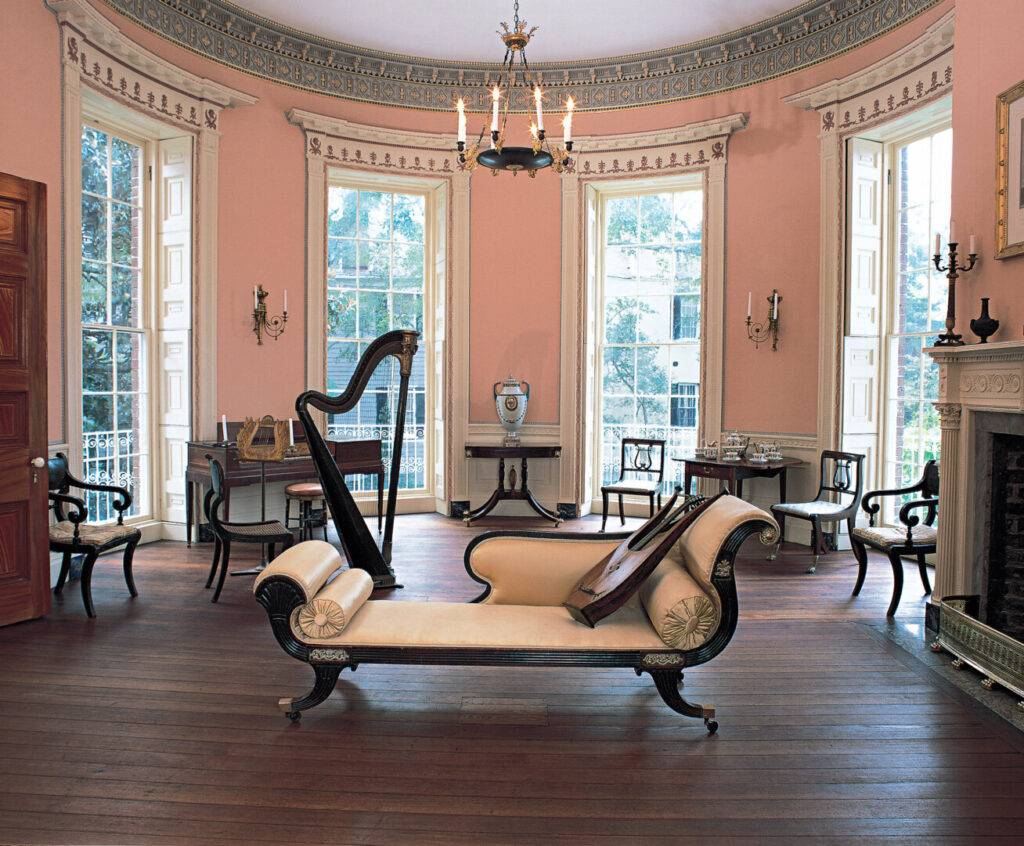
Courtesy National Trust
Upholstering walls, or just lining them with fabric, creates luxury. “You feel a hushed intimacy when you’re in a room, or in an alcove, that’s fitted with fabric walls,” says historian and lace lord Dan Cooper. Fabric-lined walls go back to the hung tapestries of the Middle Ages. During the 20th-century Craftsman era, burlap and other coarse textiles filled the spaces between wainscot battens. Silk damask is popular for French or Neoclassical interiors, on the whole wall or fitted into panels. Avoid upholstery-weight goods, as gravity will cause sagging. Fabric may be attached with liquid starch, an adhesive; or by framing the perimeter of each wall with a tacking strip, then stapling the fabric onto the strips. A layer of puffy batting attached to the wall before it’s covered adds sumptuousness and deadens the acoustics. Hide staples with gimp, ribbon, or decorative tacks.
Wood is another material to consider. Beadboard, a 19th-century standard, has become wildly popular for kitchens and baths, ceilings, and wainscoting. Shiplap boards were once a common interior wall material, later covered over but now seen as a finished wall. Wood shingles or bark have been used in enclosed porches and Rustic architecture. Another choice is tile—for entire walls, as a low or high wainscot, or inserted as a decorative panel or medallion.
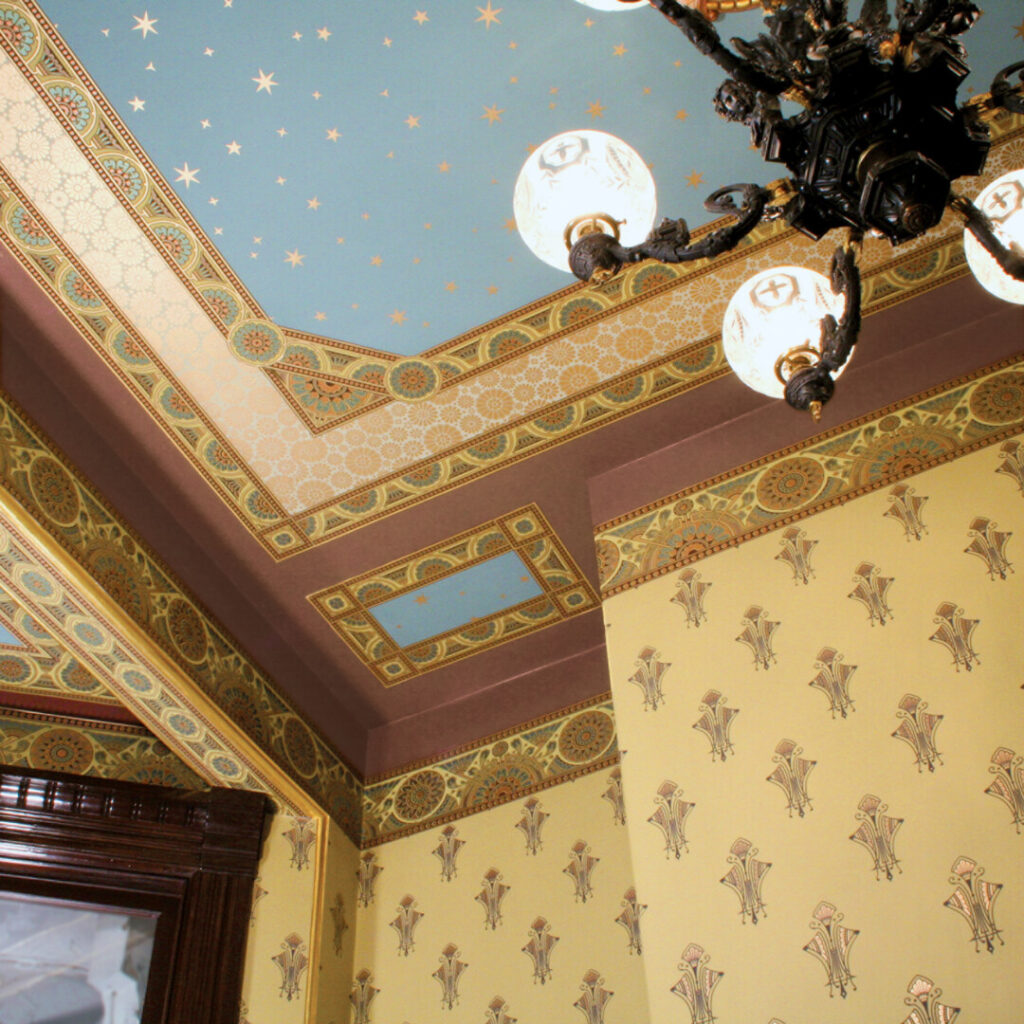
Wallpaper
Shunned by 20th-century modernists, wallpaper enjoyed renewed popularity during the more recent Victorian and Arts & Crafts revivals. Today we find it being used in new ways: to create a feature wall in a painted room; on the back wall of a bookcase. Older methods of manufacture have been joined by digital printing (which allows re-scaling) and options such as peel-and-stick papers.
At the same time, historical papers are back in a big way. Bradbury & Bradbury has introduced Vintage collections spanning the 1920s through the 1960s.The venerable Thomas Strahan collections offer murals in panels and designs from their archives.
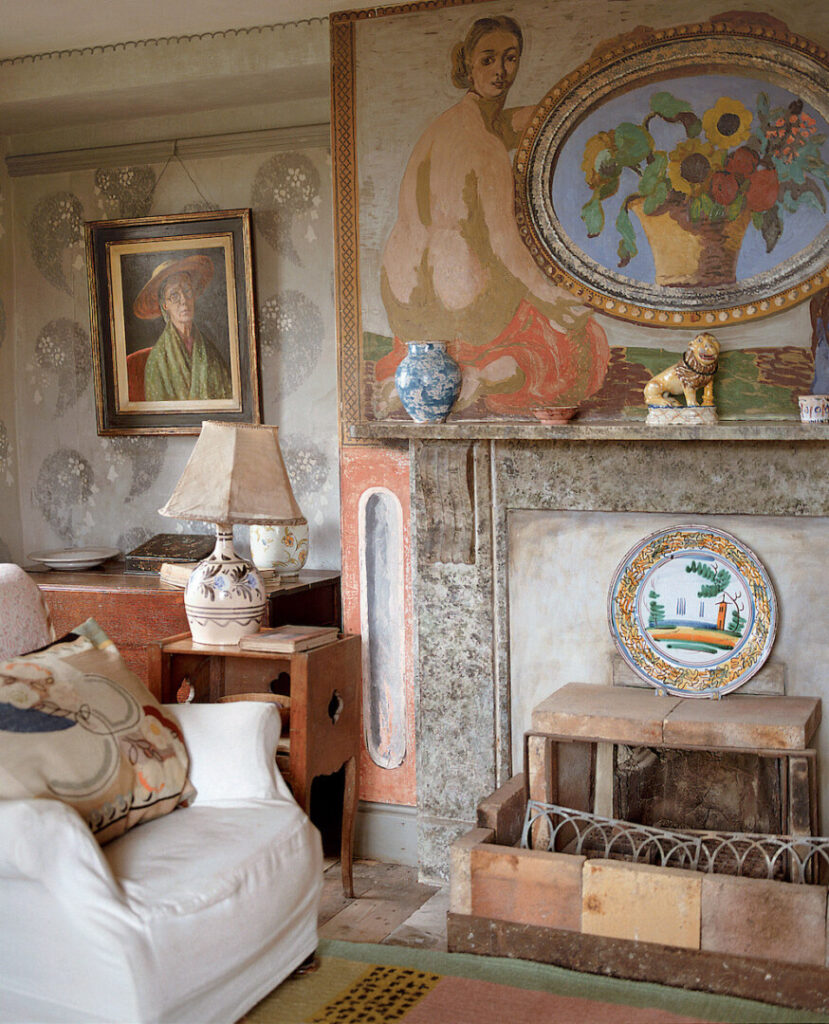
Susan Sully, Courtesy Gibbs Smith
The painted wall
Whitewash and milk paint go way back as American interior finishes. Freehand painting (on wet or dry plaster), stenciling, stippling, sponging, and striping are ancient treatments still in general use. Paint is affordable and endlessly variable. Even changing the sheen, from flat or eggshell to gloss, creates interest.
Stenciling is another affordable option, albeit one involving a fair amount of labor. Sometimes associated with Colonial-era homes as a homespun alternative to imported wallpapers, the stencil tradition was huge during the Victorian era, often involving intricate, polychrome Aesthetic designs requiring multiple stencil templates. It was also popular during the Arts & Crafts era, when magazines instructed housewives on how to stencil walls in their bungalows.
In many schemes, of course, paint marries well with wallpaper. Classic treatments (lending different proportions) include the papered frieze over a plain, painted wall fill, and a papered wall over a painted wood wainscot.
While less common than paint-decorated plaster, a paint-on-wood tradition exists: think of the rosemaling of rural Norway and Sweden. Stenciling on painted, shiplapped boards survives in some early American houses.
The history is rich
Traditions survive, but you can find precedent for anything you might want to do. Color and pattern have been intense since Pompeii; early American houses wore Prussian blue and salmon, and used wallpaper borders we find almost garish today. Muted tone-on-tone patterns always have been an alternative to more colorful schemes. Paper has migrated to ceilings, and been cut and decoupaged. Mural papers are a reminder that a similar but unique treatment may be done with freehand painting.
Walls vocabulary
• anaglypta A lightweight embossed material made of cotton pulp, to be painted or faux-finished after installation.
• border A narrow strip of small repeating pattern, whether stencil or paper, used to highlight the architecture of a room (as around doors or windows).
• chair rail A narrow moulding above the dado or wainscot, originally used to protect the wall against chair backs, and useful to create a pattern break.
• crown/cornice The moulding, usually plaster or wood, at the top of the wall, abutting the ceiling.
• dado Treatment for the bottom of the wall, between the baseboard and chair rail, where a wainscot would be.
•fill(ing) Color or pattern used in the main portion of a wall, between the dado below and frieze above.
• frieze A horizontal band along the upper part of a wall, or the design intended for that space.
• lincrusta-walton A heavy, rigid, embossed wallcovering made of linseed oil, with deep relief, to be given a finish after installation.
• panelize A decorative treatment in which mouldings are used to create framed panels on the wall. The panels may be painted in a different color, or wallpapered.
• picture rail A narrow moulding near or below the cornice from which framed pictures could be suspended on wires and hooks. The area above might be treated as part of the wall or part of the ceiling.
• polychrome To decorate in many or various colors, from the Greek words for multiple and color.
• stencil Repeating ornament applied in paint through a design cut out of a template, usually paperboard or Mylar.
• wainscot Traditionally, it is wood cladding on the lower section of wall, corresponding to classical proportions, and may be flat boards, raised-panel, beadboard, etc.







